Some years we get spectacular drifts of Monarchs migrating south, and some years they come in little groups of three or four…not many at a time. Today I went out on a day of blue sky, bright sun, brisk north wind, just to see what was out there.
Maximilian sunflower is an native prairie plant; we had remnants of it here and there, and it’s spread under our management. Butterflies nectar on the flowers, birds and other wildlife eat the seeds.
The Maximilian sunflowers are blooming well this year, though they’re all short, less than half the height they are when never short of water. But the Monarch butterflies don’t care, as long as the flowers are there.
Monarchs in fall nectar on a variety of plants: frostweed, gayfeather, Maximilian sunflower, and–the first time I’ve seen this–purple gerardia. As it was a windy day, and this monarch was struggling to stay on the flower, I had time for only one shot–and it turned impressionist:
I saw several other Monarchs–including another one on Maximilian sunflower–but they were too far away, or flying too fast, or otherwise unsuitable subjects. However, though most of my Monarch pictures this year have been of males, the one that gave me the best images was a female (and spent a lot of time at each flower, allowing time for enough images to get that 5-10% of good ones.)
You can tell she’s a female because the veins on the wings are thicker and there’s not the scent-patch on the hind wing (shows as a wide spot on a thinner vein.) Here’s a male (photographed two years ago on Liatris (gayfeather, blazing star):
You can see that the hind-wing veins are thinner, and one has a little ‘blip” on it.
Although it’s generally thought Monarchs don’t reproduce in September in our area, I’ve twice photographed Monarch larvae in late September. This year one appeared on a board 8 feet up in the air during construction of an arbor. Not the best place to pupate.
We were careful not to bump the board, but it disappeared overnight after a couple of days.
Monarchs aren’t the only butterflies out there: we’re still seeing both Tiger Swallowtails and Giant Swallowtails (neither will slow down for a picture right now), as well as many smaller butterflies: Gulf Fritillary, Variegated Fritillary, Hackberry Emperor, Empress Leila, Orange Sulphur, Common Buckeye, Queen, and more. Here’s an Orange Sulphur on one of the wiry little fall asters.
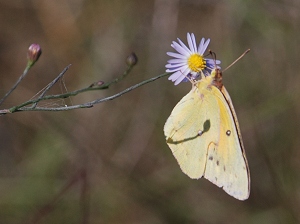
But we have many of those other butterflies through the summer…when we don’t have monarchs. Monarchs in fall deserve a celebration.
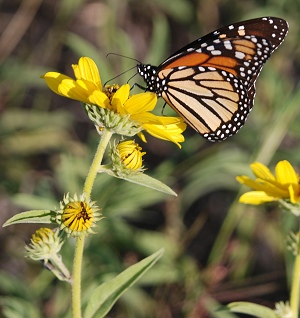
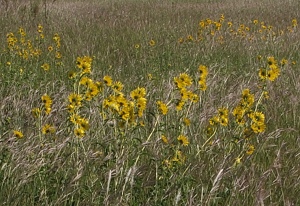
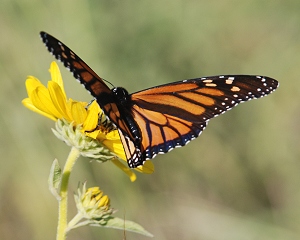
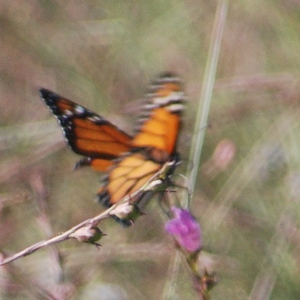
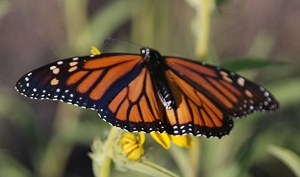
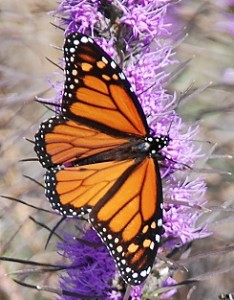
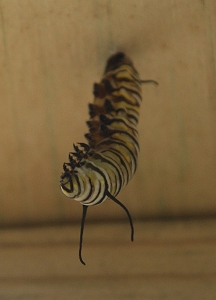
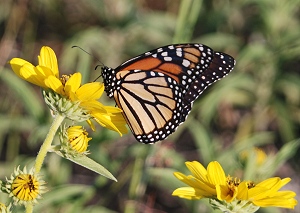
Comment by Doranna — October 3, 2010 @ 9:52 pm
Oh, beautiful!
Comment by cdozo — October 4, 2010 @ 7:31 am
Beautiful photographs. I love the sulphur on the aster.
And you’ve identified yet another flower for me. After the flood last month, I got a bunch of purple flowers which I now know are purple gerardia. Thanks.
Unfortunately I have very few sunflowers at the land this year and very few showey flowers in general. As a result, I have less butterflies. But I have seen some pretty ones and I have plenty of other critters too.
Comment by Ellen McLean — October 18, 2010 @ 4:00 pm
We have had a fairly thick cloud of monarchs for the past two days but they are thinner today. I always think of the monarchs as our fall color.
Grandson, Daniel, had monarchs at his three year old birthday. That’s a pretty nifty natural celebration of his nativity.